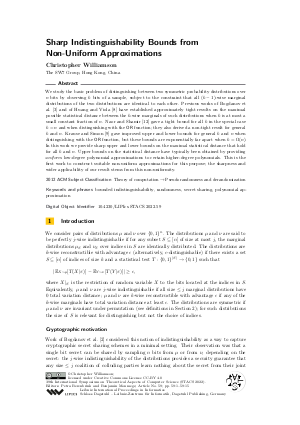Sharp Indistinguishability Bounds from Non-Uniform Approximations
Author Christopher Williamson
-
Part of:
Volume:
39th International Symposium on Theoretical Aspects of Computer Science (STACS 2022)
Part of: Series: Leibniz International Proceedings in Informatics (LIPIcs)
Part of: Conference: Symposium on Theoretical Aspects of Computer Science (STACS) - License:
 Creative Commons Attribution 4.0 International license
Creative Commons Attribution 4.0 International license
- Publication Date: 2022-03-09
File

PDF
LIPIcs.STACS.2022.59.pdf
- Filesize: 0.65 MB
- 15 pages
Document Identifiers
Subject Classification
ACM Subject Classification
- Theory of computation → Pseudorandomness and derandomization
Keywords
- bounded indistinguishability
- randomness
- secret sharing
- polynomial approximation
Metrics
- Access Statistics
-
Total Accesses (updated on a weekly basis)
0PDF Downloads0Metadata Views
Abstract
We study the basic problem of distinguishing between two symmetric probability distributions over n bits by observing k bits of a sample, subject to the constraint that all (k-1)-wise marginal distributions of the two distributions are identical to each other. Previous works of Bogdanov et al. [Bogdanov et al., 2019] and of Huang and Viola [Huang and Viola, 2019] have established approximately tight results on the maximal possible statistical distance between the k-wise marginals of such distributions when k is at most a small constant fraction of n. Naor and Shamir [Naor and Shamir, 1994] gave a tight bound for all k in the special case k = n and when distinguishing with the OR function; they also derived a non-tight result for general k and n. Krause and Simon [Krause and Simon, 2000] gave improved upper and lower bounds for general k and n when distinguishing with the OR function, but these bounds are exponentially far apart when k = Ω(n). In this work we provide sharp upper and lower bounds on the maximal statistical distance that hold for all k and n. Upper bounds on the statistical distance have typically been obtained by providing uniform low-degree polynomial approximations to certain higher-degree polynomials. This is the first work to construct suitable non-uniform approximations for this purpose; the sharpness and wider applicability of our result stems from this non-uniformity.
Cite As Get BibTex
Christopher Williamson. Sharp Indistinguishability Bounds from Non-Uniform Approximations. In 39th International Symposium on Theoretical Aspects of Computer Science (STACS 2022). Leibniz International Proceedings in Informatics (LIPIcs), Volume 219, pp. 59:1-59:15, Schloss Dagstuhl – Leibniz-Zentrum für Informatik (2022)
https://doi.org/10.4230/LIPIcs.STACS.2022.59
BibTex
@InProceedings{williamson:LIPIcs.STACS.2022.59,
author = {Williamson, Christopher},
title = {{Sharp Indistinguishability Bounds from Non-Uniform Approximations}},
booktitle = {39th International Symposium on Theoretical Aspects of Computer Science (STACS 2022)},
pages = {59:1--59:15},
series = {Leibniz International Proceedings in Informatics (LIPIcs)},
ISBN = {978-3-95977-222-8},
ISSN = {1868-8969},
year = {2022},
volume = {219},
editor = {Berenbrink, Petra and Monmege, Benjamin},
publisher = {Schloss Dagstuhl -- Leibniz-Zentrum f{\"u}r Informatik},
address = {Dagstuhl, Germany},
URL = {https://drops.dagstuhl.de/entities/document/10.4230/LIPIcs.STACS.2022.59},
URN = {urn:nbn:de:0030-drops-158692},
doi = {10.4230/LIPIcs.STACS.2022.59},
annote = {Keywords: bounded indistinguishability, randomness, secret sharing, polynomial approximation}
}
Author Details
References
-
RW Barnard, Germund Dahlquist, K Pearce, Lothar Reichel, and KC Richards. Gram polynomials and the kummer function. Journal of approximation theory, 94(1):128-143, 1998.

-
Andrej Bogdanov, Yuval Ishai, Emanuele Viola, and Christopher Williamson. Bounded indistinguishability and the complexity of recovering secrets. In CRYPTO, 2016.

-
Andrej Bogdanov, Nikhil S Mande, Justin Thaler, and Christopher Williamson. Approximate degree, secret sharing, and concentration phenomena. RANDOM, 2019.

-
Andrej Bogdanov and Christopher Williamson. Approximate bounded indistinguishability. In ICALP, 2017.

-
H. Buhrman, R. Cleve, R. de Wolf, and C. Zalka. Bounds for small-error and zero-error quantum algorithms. In IEEE Symp. on Foundations of Computer Science (FOCS), 1999.

-
Mark Bun and Justin Thaler. Dual lower bounds for approximate degree and markov-bernstein inequalities. Information and Computation, 243:2-25, 2015.

-
Ronald de Wolf. A note on quantum algorithms and the minimal degree of epsilon-error polynomials for symmetric functions. arXiv preprint arXiv:0802.1816, 2008.

-
Xuangui Huang and Emanuele Viola. Approximate degree-weight and indistinguishability. In Electronic Colloquium on Computational Complexity (ECCC), volume 26, page 85, 2019.

-
Matthias Krause and Hans Ulrich Simon. Determining the optimal contrast for secret sharing schemes in visual cryptography. In Gaston H. Gonnet and Alfredo Viola, editors, LATIN 2000: Theoretical Informatics, volume 1776 of Lecture Notes in Computer Science, pages 280-291. Springer Berlin Heidelberg, 2000.

-
Christian Kuhlmann and Hans Ulrich Simon. Construction of visual secret sharing schemes with almost optimal contrast. In Symposium on Discrete Algorithms: Proceedings of the eleventh annual ACM-SIAM symposium on Discrete algorithms, volume 9 (11), pages 263-272, 2000.

-
Marvin Minsky and Seymour Papert. Perceptrons. MIT Press, Cambridge, MA, 1969.

-
Moni Naor and Adi Shamir. Visual cryptography. In Advances in Cryptology - EUROCRYPT'94, volume 950 of Lecture Notes in Computer Science, pages 1-12. Springer Berlin Heidelberg, 1994.

-
DJ Newman and TJ Rivlin. Approximation of monomials by lower degree polynomials. aequationes mathematicae, 14(3):451-455, 1976.

-
Noam Nisan and Mario Szegedy. On the degree of Boolean functions as real polynomials. Computational Complexity, 4:301-313, 1994.

-
Ramamohan Paturi. On the degree of polynomials that approximate symmetric boolean functions (preliminary version). In ACM Symp. on the Theory of Computing (STOC), pages 468-474, 1992.

- Sushant Sachdeva and Nisheeth Vishnoi. Approximation theory and the design of fast algorithms. arXiv preprint, 2013. URL: http://arxiv.org/abs/1309.4882.
-
Alexander A. Sherstov. The pattern matrix method for lower bounds on quantum communication. In 40th ACM Symp. on the Theory of Computing (STOC), pages 85-94, 2008.

-
Alexander A Sherstov. Approximate inclusion-exclusion for arbitrary symmetric functions. Computational Complexity, 18(2):219-247, 2009.

